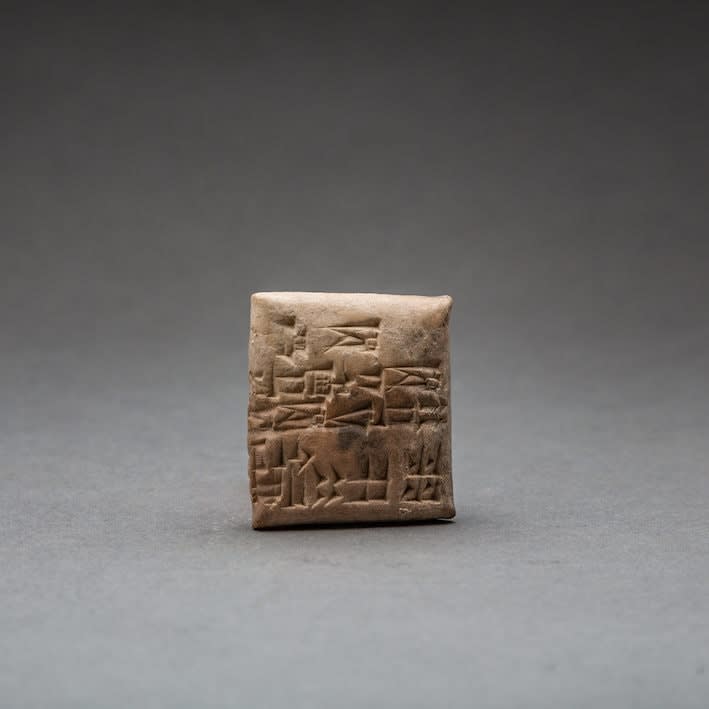Sumerian Cuneiform Tablet, 2027 BCE
Clay
1.65 x 1.88
CT.033
Sumerian Cuneiform is one of the earliest known forms of written expression. First appearing in the 4th millennium BC in what is now Iraq, it was dubbed cuneiform (“wedge-shaped”) because...
Sumerian Cuneiform is one of the earliest known forms of written expression. First appearing in the 4th millennium BC in what is now Iraq, it was dubbed cuneiform (“wedge-shaped”) because of the distinctive wedge form of the letters, created by pressing a reed stylus into wet clay. Early Sumerian writings were essentially pictograms, which became simplified in the early and mid 3rd millennium BC to a series of strokes, along with a commensurate reduction in the number of discrete signs used (from c.1500 to 600). The script system had a very long life and was used by the Sumerians as well as numerous later groups – notably the Assyrians, Elamites, Akkadians and Hittites – for around three thousand years. Certain signs and phonetic standards live on in modern languages of the Middle and Far East, but the writing system is essentially extinct. It was therefore cause for great excitement when the ‘code’ of ancient cuneiform was cracked by a group of English, French and German Assyriologists and philologists in the mid 19th century AD. This opened up a vital source of information about these ancient groups that could not have been obtained in any other way.
Cuneiform was used on monuments dedicated to heroic – and usually royal – individuals, but perhaps its most important function was that of record keeping. The palace-based society at Ur and other large urban centres was accompanied by a remarkably complex and multifaceted bureaucracy, which was run by professional administrators and a priestly class, all of whom were answerable to central court control. Most of what we know about the way the culture was run and administered comes from cuneiform tablets, which record the everyday running of the temple and palace complexes in minute detail, as in the present case. The Barakat Gallery has secured the services of Professor Lambert (University of Birmingham), a renowned expert in the decipherment and translation of cuneiform, to examine and process the information on these tablets. The following is a transcription of his analysis of this tablet:
This tablet consists of 9 lines of Sumerian cuneiform. It is written in a very large, clear scribal band recording the work of a large number of serfs working for a large temple estate. It is dated to the second year of Ibbi-Sin, last king of the Third Dynasty of Ur, c. 2027 BC.
Translation:
2682 serfs for one day: reaped, gathered and flailed flax, and took it to the town Sarik.
Foreman: Alo-lissu. Via Lugal-imru’a.
Year: the high priestess of Inanna of Uruk was chosen by divination.
Serfs in this civilization were tied to their jobs, but were free in hours off from work. The vast number given in this tablet surely implies that the whole labour force of this temple was employed in harvesting on this occasion, which is nothing surprising. The tablet is important for one contentious matter. What we have translated “flax” was the source of vegetable oil for the Sumerians, but some think it should be translated “sesame”. This tablet seems to be unique in the terms it employs for the process of harvesting, and our “gathered” may not in fact be certain. If the meaning could be established with certainty, it might help settle the identification of the Sumerian term “oil plant” which, with prefixed “grain of”, is either flask or sesame.
Cuneiform was used on monuments dedicated to heroic – and usually royal – individuals, but perhaps its most important function was that of record keeping. The palace-based society at Ur and other large urban centres was accompanied by a remarkably complex and multifaceted bureaucracy, which was run by professional administrators and a priestly class, all of whom were answerable to central court control. Most of what we know about the way the culture was run and administered comes from cuneiform tablets, which record the everyday running of the temple and palace complexes in minute detail, as in the present case. The Barakat Gallery has secured the services of Professor Lambert (University of Birmingham), a renowned expert in the decipherment and translation of cuneiform, to examine and process the information on these tablets. The following is a transcription of his analysis of this tablet:
This tablet consists of 9 lines of Sumerian cuneiform. It is written in a very large, clear scribal band recording the work of a large number of serfs working for a large temple estate. It is dated to the second year of Ibbi-Sin, last king of the Third Dynasty of Ur, c. 2027 BC.
Translation:
2682 serfs for one day: reaped, gathered and flailed flax, and took it to the town Sarik.
Foreman: Alo-lissu. Via Lugal-imru’a.
Year: the high priestess of Inanna of Uruk was chosen by divination.
Serfs in this civilization were tied to their jobs, but were free in hours off from work. The vast number given in this tablet surely implies that the whole labour force of this temple was employed in harvesting on this occasion, which is nothing surprising. The tablet is important for one contentious matter. What we have translated “flax” was the source of vegetable oil for the Sumerians, but some think it should be translated “sesame”. This tablet seems to be unique in the terms it employs for the process of harvesting, and our “gathered” may not in fact be certain. If the meaning could be established with certainty, it might help settle the identification of the Sumerian term “oil plant” which, with prefixed “grain of”, is either flask or sesame.



